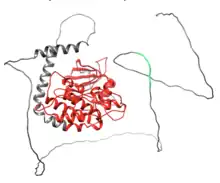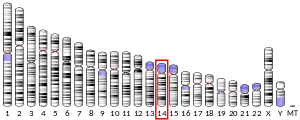Receptor-interacting serine/threonine-protein kinase 3 is an enzyme that is encoded by the RIPK3 gene in humans.[5][6][7][8]
The product of this gene is a member of the receptor-interacting protein (RIP) family of serine/threonine protein kinases. It contains a C-terminal domain unique from other RIP family members. The encoded protein is predominantly localized to the cytoplasm, and can undergo nucleocytoplasmic shuttling dependent on novel nuclear localization and export signals. It is a component of the tumor necrosis factor (TNF) receptor-I signaling complex, and can induce necroptosis by interaction with RIPK1 and MLKL in a protein complex termed the necrosome.[7] Interactions between RIPK1 and RIPK3 also form a necrosome, which triggers apoptosis.[9]

Interactions
RIPK3 has been shown to interact with RIPK1 to form an amyloid spine[5][8] The RIP Homotypic Interaction Motifs (RHIM) of RIPK3 allows it to form a necrosome with RIPK1.[9] This interaction makes heterotypic β sheets, which bind together to form an alternating “ladder” of Serine from RIPK1 and Cysteine from RIPK3.[9]
References
- 1 2 3 ENSG00000285379 GRCh38: Ensembl release 89: ENSG00000129465, ENSG00000285379 - Ensembl, May 2017
- 1 2 3 GRCm38: Ensembl release 89: ENSMUSG00000022221 - Ensembl, May 2017
- ↑ "Human PubMed Reference:". National Center for Biotechnology Information, U.S. National Library of Medicine.
- ↑ "Mouse PubMed Reference:". National Center for Biotechnology Information, U.S. National Library of Medicine.
- 1 2 Yu PW, Huang BC, Shen M, Quast J, Chan E, Xu X, et al. (May 1999). "Identification of RIP3, a RIP-like kinase that activates apoptosis and NFkappaB". Current Biology. 9 (10): 539–542. doi:10.1016/S0960-9822(99)80239-5. PMID 10339433.
- ↑ Sun X, Lee J, Navas T, Baldwin DT, Stewart TA, Dixit VM (June 1999). "RIP3, a novel apoptosis-inducing kinase". The Journal of Biological Chemistry. 274 (24): 16871–16875. doi:10.1074/jbc.274.24.16871. PMID 10358032.
- 1 2 "Entrez Gene: RIPK3 receptor-interacting serine-threonine kinase 3".
- 1 2 Li J, McQuade T, Siemer AB, Napetschnig J, Moriwaki K, Hsiao YS, et al. (July 2012). "The RIP1/RIP3 necrosome forms a functional amyloid signaling complex required for programmed necrosis". Cell. 150 (2): 339–350. doi:10.1016/j.cell.2012.06.019. PMC 3664196. PMID 22817896.
- 1 2 3 Mompeán M, Li W, Li J, Laage S, Siemer AB, Bozkurt G, et al. (May 2018). "The Structure of the Necrosome RIPK1-RIPK3 Core, a Human Hetero-Amyloid Signaling Complex". Cell. 173 (5): 1244–1253.e10. doi:10.1016/j.cell.2018.03.032. PMC 6002806. PMID 29681455.
- ↑ "RIPK3 - Receptor-interacting serine/threonine-protein kinase 3 - Homo sapiens (Human) - RIPK3 gene & protein". www.uniprot.org. Retrieved 2022-05-13.
Further reading
- Kasof GM, Prosser JC, Liu D, Lorenzi MV, Gomes BC (May 2000). "The RIP-like kinase, RIP3, induces apoptosis and NF-kappaB nuclear translocation and localizes to mitochondria". FEBS Letters. 473 (3): 285–291. doi:10.1016/S0014-5793(00)01473-3. PMID 10818227.
- Sun X, Yin J, Starovasnik MA, Fairbrother WJ, Dixit VM (March 2002). "Identification of a novel homotypic interaction motif required for the phosphorylation of receptor-interacting protein (RIP) by RIP3". The Journal of Biological Chemistry. 277 (11): 9505–9511. doi:10.1074/jbc.M109488200. PMID 11734559.
- Strausberg RL, Feingold EA, Grouse LH, Derge JG, Klausner RD, Collins FS, et al. (December 2002). "Generation and initial analysis of more than 15,000 full-length human and mouse cDNA sequences". Proceedings of the National Academy of Sciences of the United States of America. 99 (26): 16899–16903. Bibcode:2002PNAS...9916899M. doi:10.1073/pnas.242603899. PMC 139241. PMID 12477932.
- Bouwmeester T, Bauch A, Ruffner H, Angrand PO, Bergamini G, Croughton K, et al. (February 2004). "A physical and functional map of the human TNF-alpha/NF-kappa B signal transduction pathway". Nature Cell Biology. 6 (2): 97–105. doi:10.1038/ncb1086. PMID 14743216. S2CID 11683986.
- Meylan E, Burns K, Hofmann K, Blancheteau V, Martinon F, Kelliher M, Tschopp J (May 2004). "RIP1 is an essential mediator of Toll-like receptor 3-induced NF-kappa B activation" (PDF). Nature Immunology. 5 (5): 503–507. doi:10.1038/ni1061. PMID 15064760. S2CID 12570157.
- Yang Y, Ma J, Chen Y, Wu M (September 2004). "Nucleocytoplasmic shuttling of receptor-interacting protein 3 (RIP3): identification of novel nuclear export and import signals in RIP3". The Journal of Biological Chemistry. 279 (37): 38820–38829. doi:10.1074/jbc.M401663200. PMID 15208320.
- Yang Y, Hu W, Feng S, Ma J, Wu M (June 2005). "RIP3 beta and RIP3 gamma, two novel splice variants of receptor-interacting protein 3 (RIP3), downregulate RIP3-induced apoptosis". Biochemical and Biophysical Research Communications. 332 (1): 181–187. doi:10.1016/j.bbrc.2005.04.114. PMID 15896315.
- Kimura K, Wakamatsu A, Suzuki Y, Ota T, Nishikawa T, Yamashita R, et al. (January 2006). "Diversification of transcriptional modulation: large-scale identification and characterization of putative alternative promoters of human genes". Genome Research. 16 (1): 55–65. doi:10.1101/gr.4039406. PMC 1356129. PMID 16344560.
- Zhao L, Wang G, Lu D, Wu J, Song F, Dong J, et al. (June 2006). "Homocysteine, hRIP3 and congenital cardiovascular malformations". Anatomy and Embryology. 211 (3): 203–212. doi:10.1007/s00429-005-0074-9. PMID 16429275. S2CID 7176317.
- Feng S, Ma L, Yang Y, Wu M (September 2006). "Truncated RIP3 (tRIP3) acts upstream of FADD to induce apoptosis in the human hepatocellular carcinoma cell line QGY-7703". Biochemical and Biophysical Research Communications. 347 (3): 558–565. doi:10.1016/j.bbrc.2006.06.118. PMID 16844082.
- Ahn KS, Sethi G, Krishnan K, Aggarwal BB (January 2007). "Gamma-tocotrienol inhibits nuclear factor-kappaB signaling pathway through inhibition of receptor-interacting protein and TAK1 leading to suppression of antiapoptotic gene products and potentiation of apoptosis". The Journal of Biological Chemistry. 282 (1): 809–820. doi:10.1074/jbc.M610028200. PMID 17114179.



